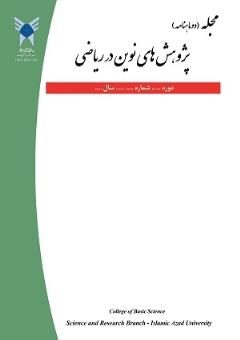جاذبهـای آشوبناک و متناوب در یک مدل شبکه عصبی مصنوعی پنج بعدی
محورهای موضوعی : هندسه
1 - گروه ریاضی، دانشگاه پیام نور، تهران، ایران
کلید واژه:
چکیده مقاله :
در این مقاله، دینامیک یک مدل جدید از شبکههای عصبی هاپفیلد مبتنی بر 5 نورون ارائه و بررسی شده است. در ضرائب سیناپسی این مدل، دو پارامتر تعریف شده که با تغییر آنها، رفتارهای دینامیکی بسیار غنی، از جمله جاذب شبهمتناوب (3-چنبره)، آشوب، آشوب گذرا، ابرآشوب، انشعاب دو برابر سازی دوره تناوب منتهی به آشوب و جاذبهای همزیست مشاهده خواهند شد. این مدل تقریبا اکثر پدیدههای دینامیکی مطرح را در بر خواهد گرفت. به طور خاص، ما پدیده انشعاب دو برابر سازی دوره تناوب منتهی به آشوب را مشاهده میکنیم که در کارهای قبلی به ندرت در سیستمهای خودگردان پنج بعدی، بخصوص سیستم هاپفیلد گزارش شدهاند. با تغییر پارامتر a در یک بازه بسیار کوچک، فرآیند تکامل سیستم از چرخه حدی آغاز میشود و پس از عبور از یک سری جاذبهای متناوب، آشوبناک میشود. رفتارهای پیچیده دینامیکی سیستم با استفاده از طیف نمای لیاپونوف، نمودار انشعاب و مقاطع مختلف از فضای فاز بررسی میشوند.
In this article, the dynamics of a new model of Hopfield neural networks based on 5 neurons is presented and analyzed. In the synaptic coefficients of this model, two parameters are defined which, by changing them, very rich dynamic behaviors, including quasi-periodic attractors (3-torus), chaos, transient chaos, hyperchaos, period-doubling bifurcation route to chaos and coexistence attractors will be observed. This model will include almost most of the dynamic phenomena mentioned. In particular, we observe the period-doubling bifurcation leading to chaos, which has rarely been reported in previous works in five-dimensional autonomous systems, especially the Hopfield system. By changing the parameter a in a very small interval, the evolution process of the system starts from the limit cycle and after passing through a series of periodic attractors, it becomes chaotic. Complex dynamic behaviors of the system are investigated using the Lyapunov spectrum, bifurcation diagram and different sections of the phase space.

